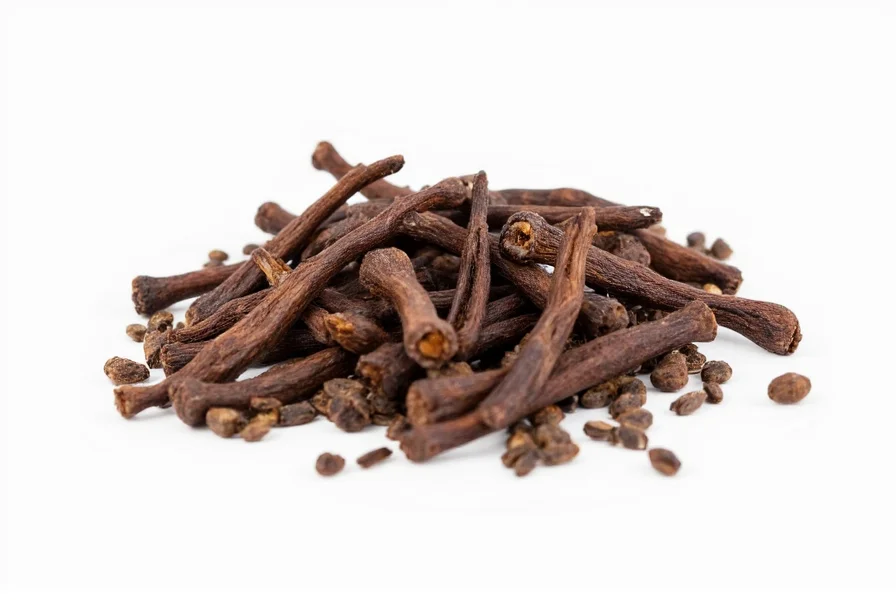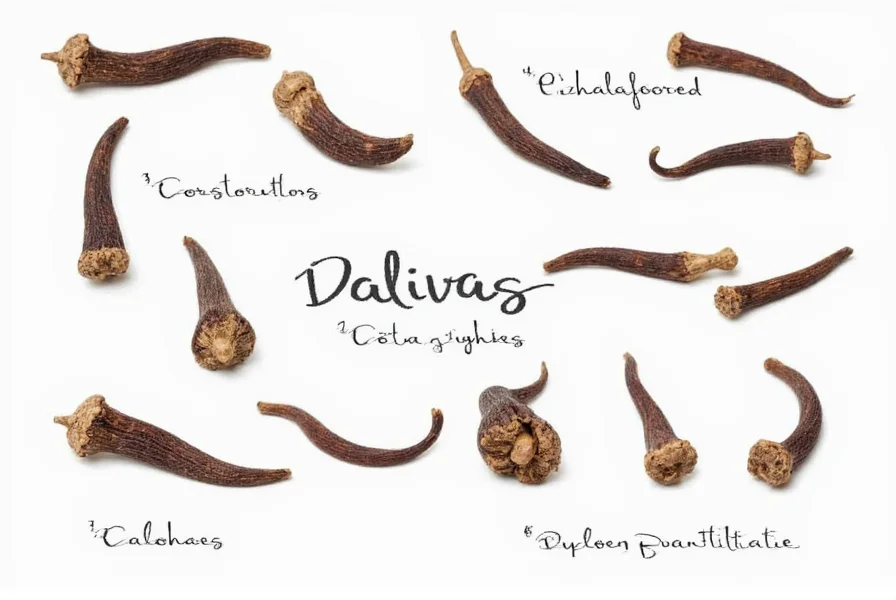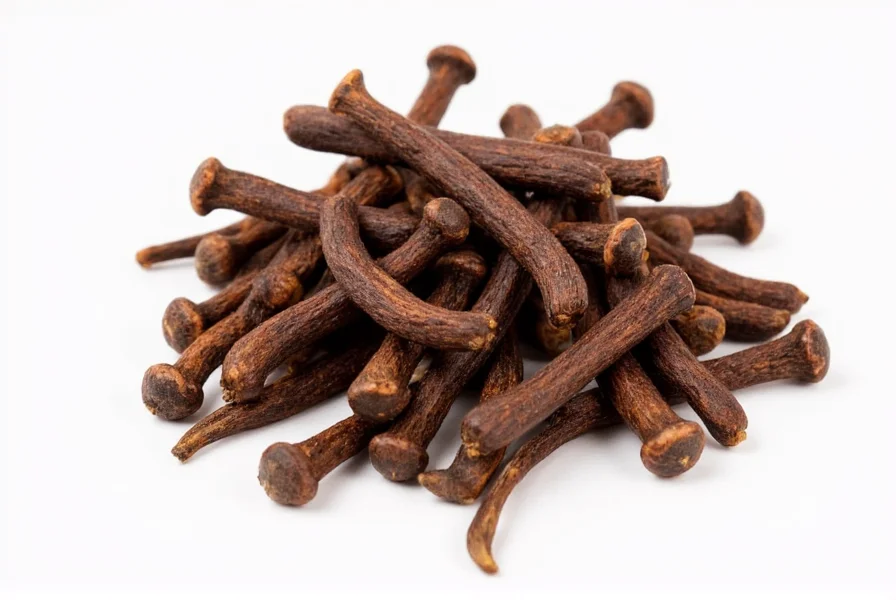When searching for a picture of cloves, you'll notice their distinctive appearance that makes them easily recognizable among spices. These aromatic buds serve as one of the world's oldest and most widely used spices, valued for both culinary and medicinal applications across cultures.
Visual Characteristics of Whole Cloves
Whole cloves possess several identifying features that help distinguish them from other spices. The typical clove measures 10-15 millimeters in length with a diameter of 2-4 millimeters at the flower head. Their most recognizable trait is the nail-like shape, featuring:
- A rounded, four-pointed flower head (the "nail head")
- A long, thin stem (the "nail shaft")
- A deep reddish-brown to dark brown color when fresh
- A smooth, slightly oily texture
- A strong, sweet-spicy aroma when crushed
When examining a detailed picture of cloves, you'll notice the flower head contains four small petals arranged in a cross pattern, which becomes visible when the bud dries and the petals recede. High-quality cloves remain firm and contain ample essential oil, which you can verify by pressing them—they should release aromatic oil.

Types of Cloves and Their Visual Differences
While all cloves share the basic nail shape, different varieties show subtle visual variations. The two primary commercial types include:
| Type | Origin | Color | Size | Distinctive Features |
|---|---|---|---|---|
| Zanzibar Cloves | Tanzania | Rich reddish-brown | 12-16 mm | Bulbous head, high oil content (15-20%) |
| Indonesian Cloves | Indonesia | Dark brown | 10-14 mm | Longer stem, slightly lower oil content |
| Madagascar Cloves | Madagascar | Deep brown | 14-18 mm | Larger size, milder aroma |
Freshly harvested cloves appear pinkish when unopened, turning progressively darker as they dry. The highest quality cloves maintain a uniform color without black spots, which indicate over-drying or poor storage. When comparing picture of whole cloves versus ground cloves, note that ground cloves lose their distinctive shape but retain their characteristic warm brown color and potent aroma.
How to Identify Quality Cloves by Appearance
Visual inspection provides reliable indicators of clove quality. When examining cloves, look for these characteristics:
- Color consistency: Premium cloves display uniform reddish-brown coloring without dark spots
- Whole structure: Intact cloves with unbroken flower heads contain more essential oils
- Weight: High-quality cloves feel heavy for their size, indicating good oil content
- Stem condition: Stems should be attached and not excessively broken
- Surface texture: Should appear slightly glossy from natural oils, not dry or dusty
Cloves that appear dull, blackened, or excessively fragmented typically have lost significant aromatic compounds. When reviewing a close-up picture of cloves, you can often see tiny oil glands on the surface of high-quality specimens—these appear as minuscule dots that release the characteristic clove fragrance when pressed.
Cloves in Different Forms: Visual Comparison
Beyond whole cloves, this spice appears in several processed forms, each with distinctive visual properties:
- Whole cloves: Maintain the characteristic nail shape with reddish-brown color
- Ground cloves: Fine powder ranging from light to medium brown
- Clove stems: Thinner, more fibrous pieces often included in lower-grade products
- Clove oil: Clear to pale yellow liquid with intense aroma
- Clove buds without stems: Rounder appearance sometimes sold as "head cloves"
When searching for an accurate picture of cloves for identification, pay attention to context. Cloves used in cooking (like studded in ham) show the whole spice partially embedded in food, while botanical images highlight the unopened flower buds still on the tree. Understanding these visual contexts helps correctly identify cloves in various settings.

Common Identification Mistakes
Several spices resemble cloves visually, leading to frequent misidentification:
- Allspice berries: Often confused with cloves but are rounder, darker, and lack the distinctive nail shape
- Nutmeg seeds: Larger, oval-shaped, and lighter brown than cloves
- Star anise: Eight-pointed star shape makes it visually distinct despite similar aroma
- Peppercorns: Black peppercorns are rounder and more uniform in shape
A definitive way to distinguish cloves from similar spices is their unique combination of shape and aroma. When examining a high-resolution picture of cloves, the four-pointed flower head visible at the bulbous end provides the clearest visual differentiator from other spices.
Practical Applications Based on Appearance
The visual characteristics of cloves directly impact their culinary use. Whole cloves work best for:
- Studding hams and onions (where their shape allows easy removal)
- Braising liquids (where they infuse flavor without making the dish gritty)
- Pickling solutions (where their visual presence indicates flavor infusion)
Ground cloves suit applications where:
- Uniform flavor distribution is needed (baked goods, spice blends)
- Visual presence isn't desired (sauces, purees)
- Rapid flavor release is required (quick-cooking dishes)
Understanding these visual distinctions helps cooks select the appropriate form for their recipes. When referencing a picture of cloves in cooking context, notice how whole cloves remain visible in dishes like mulled wine or pot roast, while ground cloves disappear into mixtures like pumpkin pie spice.
Frequently Asked Questions
What does a whole clove look like?
A whole clove resembles a small nail, measuring 1-2 cm long with a bulbous, four-pointed head and thin stem. They have a rich reddish-brown color when fresh that darkens with age. The surface appears slightly glossy from natural oils, and they release a strong aromatic scent when crushed.
How can you tell the difference between cloves and allspice berries?
Cloves have a distinctive nail shape with a bulbous head and thin stem, while allspice berries are rounder and more uniform in shape. Cloves display a reddish-brown color compared to the darker brown of allspice. The most reliable visual difference is that cloves show a four-pointed flower head at the bulbous end when examined closely.
What color should good quality cloves be?
High-quality cloves display a consistent reddish-brown to medium brown color. Freshly harvested cloves start as pink buds that darken during drying. Premium cloves maintain this reddish hue without black spots or uneven coloring, which indicates over-drying or poor storage conditions.
Do ground cloves look different from whole cloves?
Yes, ground cloves form a fine, uniform powder with a rusty-brown color, while whole cloves maintain their distinctive nail shape. Ground cloves lose the visual characteristics of the flower head and stem but retain the warm brown color and strong aroma. The powder should appear consistent without dark specks or clumping.
Why do some cloves appear shiny while others look dull?
Shiny cloves contain higher levels of essential oils, indicating freshness and quality. Dull cloves have lost moisture and aromatic compounds through improper storage or age. When examining a picture of cloves, the glossiest specimens typically offer the strongest flavor and aroma.











 浙公网安备
33010002000092号
浙公网安备
33010002000092号 浙B2-20120091-4
浙B2-20120091-4